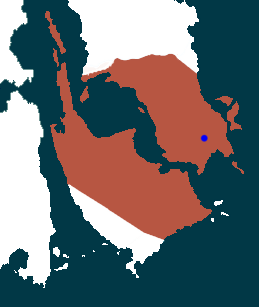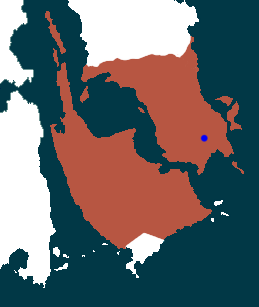Imperial State of Carinansia: Difference between revisions
No edit summary |
|||
| Line 176: | Line 176: | ||
==== House Cortés ==== | ==== House Cortés ==== | ||
Formed in June 1827, after Beltran Cortes was made the first Duke of Solicalco, it was the oldest family in the Imperial Senate. | |||
==== House Castylblanco ==== | ==== House Castylblanco ==== | ||
Revision as of 03:03, 12 May 2024
Imperial State of Carinansia Estado Imperial de Cárinansia | |||||||||
|---|---|---|---|---|---|---|---|---|---|
| 1827–1965 | |||||||||
Motto: Dios, Patria, Rei | |||||||||
Anthem: Cárinansia Suprema | |||||||||
 Map of Carinansia in 1827 | |||||||||
 Map of Carinansia in 1965 | |||||||||
| Capital | São Alberto, Kingdom of Voclaria | ||||||||
| Largest city | Voclaria City, Kingdom of Voclaria | ||||||||
| Official languages | Classical Spanic (1827-1857, 1943-1965) | ||||||||
| Common languages |
| ||||||||
| Religion |
| ||||||||
| Demonym(s) | Cárinansian | ||||||||
| Government |
| ||||||||
| Emperor | |||||||||
• 1827-1841 | Alberto I | ||||||||
• 1841-1857 | Alberto II | ||||||||
• 1857-1899 | Alberto III | ||||||||
• 1899-1939 | Alberto IV | ||||||||
• 1939-1965 | Alberto V | ||||||||
| Prime Minister | |||||||||
• 1866-1884 | Ramiro Ruiz, 2nd Marquess of Corvacho | ||||||||
• 1884-1887 | Jacobo Fraga, 3rd Lord of Villarida | ||||||||
• 1887-1900 | Beltrán Cortés, 4th Duke of Solicalco | ||||||||
• 1900-1913 | Matías Sarmiento | ||||||||
• 1919-1920 | Beltrán Cortés, 4th Duke of Solicalco | ||||||||
• 1920-1932 | Franco Manzanedo | ||||||||
• 1932-1936 | Gonzalo Tejedor | ||||||||
• 1936-1941 | Juan Hurtado | ||||||||
| Legislature | Imperial Congress | ||||||||
| Imperial Senate | |||||||||
| House of Deputies | |||||||||
| Historical era | 1827 - 1965 | ||||||||
• Moncovia Incident | October 18, 1814 | ||||||||
• Established | 16 June 1827 | ||||||||
• Arcadian Invasion of Lekeadia | 1842-1843 | ||||||||
• Promulgation of the People’s Constitution | 9 August 1966 | ||||||||
• The Distopia | 1945-1965 | ||||||||
• Disestablished | 14 June 1965 | ||||||||
| Population | |||||||||
• 1835 | 7,400,000 | ||||||||
• 1875 | 27,800,000 | ||||||||
• 1905 | 44,200,000 | ||||||||
• 1935 | 51,900,000 | ||||||||
• 1965 | 55,400,000 | ||||||||
| Currency | Imperial Peso | ||||||||
| |||||||||
| Today part of | Carinansia | ||||||||
| |||||||||
The Imperial State of Cárinansia was a state existing between 1827 and 1965, that comprised of southern Askihuac, and most of Lekeadia. Its government was an absolute monarchy under the rule of Emperor Alberto I, his son Alberto II, and his great-great grandson Alberto V, and a representative parliamentary constitutional monarchy under the rule of Emperor Alberto III, and his son Alberto IV. A centuries-old colony of the Arcadian Empire, tensions between the central government and descendants of colonists had risen over the preceding years, as protectionist measures were imposed to defend the Arcadian economy. The ultimate culmination of the Moncovia Incident, resulted in the generally-accepted beginning of the war for independence. Taking place between 1814 and 1827, Viscount Sextus Voteporix Gaius, a direct descendant of Emperor Remus Caesar Augustus declared himself Emperor Alberto I on June 16, 1827. This officially marked the beginning of an independent Carinansian state.
Unlike most of the neighboring Arcadian Oikoian states, Carinansia had political stability, vibrant economic growth, respect for civil rights of its subjects. Slavery was abolished in 1835, although it was later reinstated in 1945. The Empire's unicameral parliament was initially appointed by the Emperor, but following political reform under subsequent rulers, it was elected under comparatively democratic methods for the era, as were the provincial and local legislatures.
History
Government
Monarchy
Emperor
Read more: Emperor of Cárinansia
Imperial Family
Imperial Senate
The upper house of the Imperial Congress was composed of three types of member: Hereditary Lords, Non-hereditary appointments as lords for life, and the country’s leading members of the clergy. Originally this entailed members of the Solarian Church to participate in Senate meetings, but following the Cárinansian Reformation, only Emperor-appointed ecclesiastical figures were permitted to attend.
Of the Hereditary Lords, 20 were members of the country’s original six noble houses, established with ducal appointments shortly after Alberto I’s coronation.
House Azcona
House Cortés
Formed in June 1827, after Beltran Cortes was made the first Duke of Solicalco, it was the oldest family in the Imperial Senate.